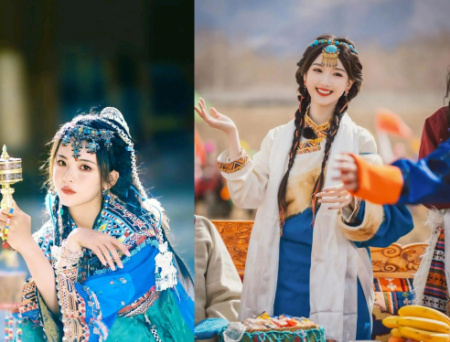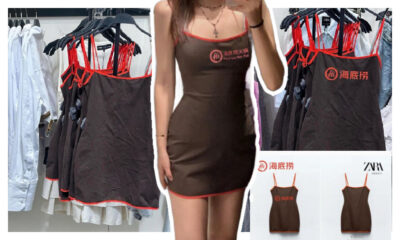China Fashion & Beauty
Clicking Into the Craze: Exploring the Rise of “Ethnic-Themed Photos” Among Chinese Tourists
Patriotic, problematic, or purely photogenic? The trend of ethnic photoshoots has sprouted across Chinese social media platforms.
Published
9 months agoon
By
Zilan Qian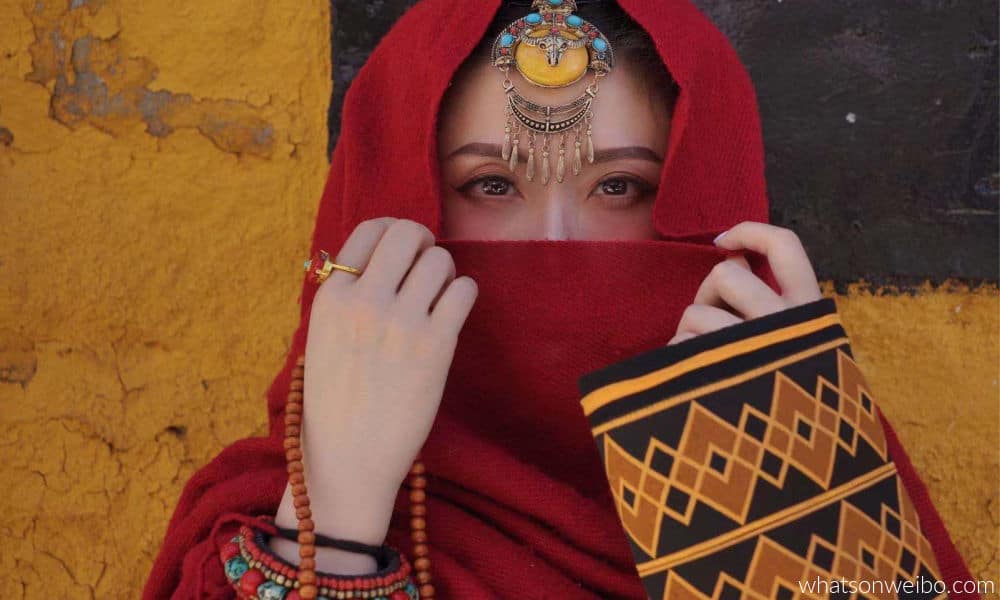
PREMIUM CONTENT
What looks like a professional photoshoot in a fashion magazine, is actually a local photo service found in one of China’s many popular tourist destinations. Dressing up as various ethnic minorities is not just a souvenir for domestic Chinese travelers; it presents a chance to indulge in a glamorous fantasy.
Exquisitely blushing cheeks, voluminous artificial eyelashes, meticulously styled hairdos, alluring ethnic garments, and enchanting landscapes. These are the captivating elements of the “ethnic-themed photo” (民族风写真) trend that has become increasingly popular on Chinese social media.
The trend is all about Chinese domestic tourists, predominantly young women, who adorn themselves in the traditional attire of China’s ethnic minorities while exploring various regions across the mainland, seeking to capture glamorous moments for their social media posts.
The favored destinations for these photoshoots predominantly encompass regions like Yunnan, Xinjiang, or Tibet— home to various Chinese ethnic communities. For the shoots, they usually wear popular ethnic dresses that are aimed to simulate those worn by people belonging to the Tibetian, Miao, Naxi, or other ethnic groups who each have their own unique cultures and traditional clothing.
Meanwhile, a flourishing industry has emerged to cater to the production of these ethnic photos for tourists. While some visitors simply rent ethnic dresses from shops, many opt for more comprehensive and professional services provided by local photo studios that offer a convenient “one-stop” experience.

Ethnic photos shared by netizens on Xiaohongshu.
Situated in popular tourist destinations, these studios not only provide an extensive selection of ethnic dresses and accessories, but also skilled makeup artists catering to individual preferences, professional photographers capturing moments throughout the daytime excursions, and photo editors perfecting the final photos.
For example, a studio located in Lijiang, Yunnan, promoting its services on the social media app Xiaohongshu, boasts a diverse collection of more than 300 dress choices along with complementary accessories. Their offerings encompass makeup services, ranging from applying false eyelashes and intricate small-scale face painting to skillfully braiding hair.

A studio located in Lijiang advertising on Xiaohongshu. It offers ethnic dresses, makeup, photography, and retouching starting as low as 59 yuan ($8.5).
The studio even promises to deliver the final retouched photos within just 24 hours. Prices for these convenient “one-stop services” differ, starting from less than 100 yuan (approximately US$14) and going up to over 1700 yuan (about US$240). The final cost depends on several factors, including the studio preference, preferred styles, the number of people in the photographs, and the quantity of retouched photos the tourists opt for.
Unique Captures: The Thriving Dress-Up Photography Industry
As the trend of snapping ethnic-inspired photos during trips gains traction in China, the idea of indulging in dress-up photoshoots with stunning makeup and glamorous outfits is not exactly new.
Photography studios specializing in diverse personal portrait services have been a fixture in China for quite a while. These all-inclusive packages usually encompass makeup, hairstyling, outfit selection, backdrop arrangement, skilled photography, and the final retouching.
Some of these studios focus on offering uniquely themed photo shoots, from Tang Dynasty to Disneyland or the magic world of Harry Potter. The customs and backdrops are usually carefully crafted to create extraordinary settings. It is quite common for people to have a series of artistic photos captured for special occasions, such as birthdays, anniversaries, graduations, or weddings (read more about wedding photoshoots in China here).

Haimati (海马体), a trending photography studio, advertising their new styles of Alice in Wonderland and Harry Potter photoshoots.
In recent years, this concept of unique photoshoot experiences has been embraced within the realm of travel. What were previously staged backgrounds painted on canvases have evolved into real tourist attractions, and the studio attire has made way for genuine local outfits. Rather than opting for Disney princesses or Hogwarts students’ costumes, Chinese tourists are now embracing a variety of outfits like kimonos, Hanbok, and Chut Thai as they explore destinations like Japan, South Korea, and Thailand.

Netizens posting photos of themselves in Chut Thai, traditional Thai clothing, when visiting Thailand on Xiaohongshu.

Netizens posting photos of themselves in Hanbok, the traditional clothing of Korea, when visiting Seoul on Xiaohongshu.

Netizens posting photos of themselves in kimonos when visiting Kyoto and Tokyo on Xiaohongshu.
The popularity of these practices has grown so much that many Chinese internet users have shared stories of mistaking young women wearing kimonos for locals and asking them for directions, only to find out they are fellow Chinese tourists. As one internet user commented on a video featuring people in kimonos in Kyoto, “It seems like around 90% of the people wearing kimonos on the streets of Kyoto are Chinese.”
In answer to this tourist trend, Chinese photography studios have started to broaden their horizons and new industries have sprung up in bustling domestic tourist spots in China. These industries offer comprehensive services similar to those provided by traditional studios, but making the people in the photographs look more exotic, elegant, and enchanting.
Following the Stars and Praising the Country: Embracing Ethnic Attire
While the trend of donning ‘exotic’ outfits for sophisticated photoshoots is not new (and not unique to China), the recent growing popularity of local photoshoots themed around Chinese ethnic minority groups is about more than China’s thriving themed-focused photography industry alone – ethnic-themed photos possess a unique appeal for Chinese travelers.
Chinese social media and celebrities have played a significant role in inspiring numerous people to embrace the ethnic clothing trend. Celebrities like Yang Chaoyue (杨超越) and Mao Xiaotong (毛晓彤) frequently appear in online conversations about ethnic-themed photography. Admiring the beauty of these celebrities in ethnic dresses, many bloggers on Xiaohongshu use their photos as references to analyze outfits and photo filters, aiming to recreate similar styles during their own travels. One Xiaohongshu user excitedly shared, “I can’t believe I achieved the same kind of ethnic look as Yang Chaoyue!” alongside a picture of herself dressed similarly to the Miao ethnic group.
Some individuals take the trend a step further by fully immersing themselves in a fantasy world through dressing up. One Chinese blogger portrays herself as a “playful chieftain’s daughter, beloved by many,” while adorned in ethnic attire. Another, set against a backdrop of snow-covered mountains, describes the liberating sensation of embodying a carefree “daughter of the gods” (神明少女) and a radiant Gesang flower (格桑花) — a bloom cherished by the Tibetan people as a sacred symbol of love and good fortune. To them, ethnic clothing offers an escape from the ordinary routines of daily life, allowing them to embrace a desirable alternate reality within their imaginations.
Furthermore, in contrast to foreign attires such as kimonos, ethnic dresses hold a unique allure as they symbolize the ethnic diversity within China, evoking a sense of patriotism among Chinese travelers.
Recently, numerous videos have emerged featuring bloggers proudly donning traditional clothing from the 55 ethnic groups, apart from the Han majority, with the goal of showcasing ‘the charm of Chinese culture.’

A screenshot from a Bilibili video featuring the blogger wearing traditional costumes of various ethnic minority groups. The video proudly presents itself as “Showcasing the beauty and allure of China’s 56 ethnic groups.”
The growing trend of ethnic photos is being embraced as a way to honor China’s abundant cultural legacy and the essence of being Chinese. “Chinese girls indeed look stunning in red,” one netizen expressed in a blog post featuring photos of her donning a vibrant red Monongalia dress, accompanied by a national flag emoji within the sentence.

A screenshot of the netizen’s Xiaohongshu post.
Perhaps unsurprisingly, this trend and its patriotic undertones have garnered support from Chinese state media, with the People’s Daily recognizing ethnic minority-themed photoshoots as a contemporary portrayal of Chinese ethnic traditions, highlighting “the distinct aesthetics inherent in Chinese traditional culture.”
Perpetuating Problematic Portrayals of Ethnic Minorities?
While there may be plenty of positive stemming from the revival of public interest in China’s ethnic minority communities through the ethnic photoshoot trend, there are also some less rose-colored consequences to consider.
Firstly, certain popular ethnic photoshoots might inadvertently perpetuate problematic portrayals of ethnic minority cultures. While ethnic photos claim to provide a glimpse into the cultures of ethnic minorities, their primary focus lies in showcasing the beauty of those being photographed for social media purposes, often at the expense of the authenticity of the minority culture they claim to represent.
The ethnic dresses provided by studios for tourists often display mismatches with local traditions. For instance, some tourists dress up as Tibetans in Miao villages, while studios located in Yunnan, home to major ethnic groups like Yi, Bai, Hani, Zhuang, Dai, and Miao, allow customers to don Uyghur outfits, even though Uyghurs are primarily found in the Xinjiang Uyghur Autonomous Region.
Additionally, many so-called ethnic dresses are often modified to serve customers’ demands. This may include incorporating elements like black chiffon skirts into traditional Miao attire or introducing ditsy floral patterns to traditional Tibetan dress.
These disparities highlight that the contemporary trend often diverges significantly from the genuine portrayal of the minorities it purports to represent (sometimes, the costumes really have more to do with imaginary minorities than representing actual traditional attire). Instead, it frequently caters more to tourists seeking a fantastical and fun experience rather than fostering genuine insights into local traditions and realities.
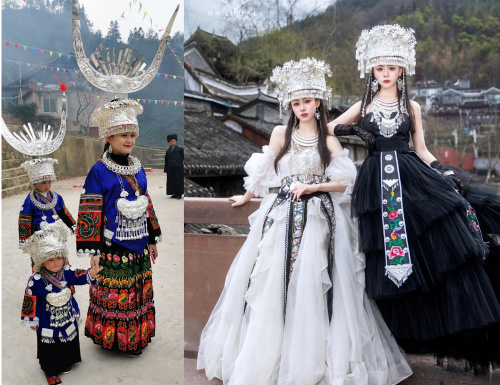
A traditional Miao dress posted by China & Asia Cultural Travel (left) and the “Miao dress” provided by a photography studio (right).

A traditional Tibetan dress posted by Tibet Vista (left) and the “Tibetan dress” provided by a photography studio.
As the ethnic photo industry continues to expand, questions also arise concerning its repercussions on local economies and the communities residing within these popular tourist spots.
Accounts from tourists in Lijiang, Yunnan, paint a vivid picture of a bustling scene, where the entire Lijiang old town is alive with visitors seeking opportunities for ethnic-themed photography. One observant netizen notes, “It’s not an exaggeration to say that you can find an ethnic photography studio every ten steps in Lijiang.”
Does this intense enthusiasm for ethnic photos actually serve as a catalyst for local economic growth? Or will it inadvertently reduce the rich cultural experience in these tourist destinations into mere picturesque settings for photography? Is there a risk of these places becoming the next Zibo, experiencing a temporary surge in popularity at the expense of the peaceful lives of local communities, only to eventually face a decline in popularity?
Chinese netizens seem less preoccupied with deeper discussions about the impact of ethnic minority representations and their influence on these tourist destinations. Online conversations are largely dominated by tourists showcasing pretty photos of themselves, while studios vigorously promote their services in a fiercely competitive market.
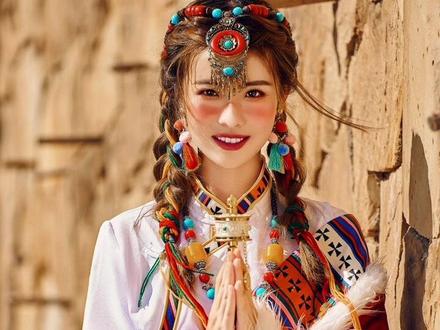
Photo by Life Photo
生活视觉女子写真摄影.
Where does the future trajectory of the trend of ethnic photos lead? Will it simply continue to exist as another form of exquisite photo service, providing people with an opportunity to escape from mundane life and experiment with different styles for cherished memories? Or will it evolve into something more significant, igniting broader discussions on cultural representations and the far-reaching influence of tourism?
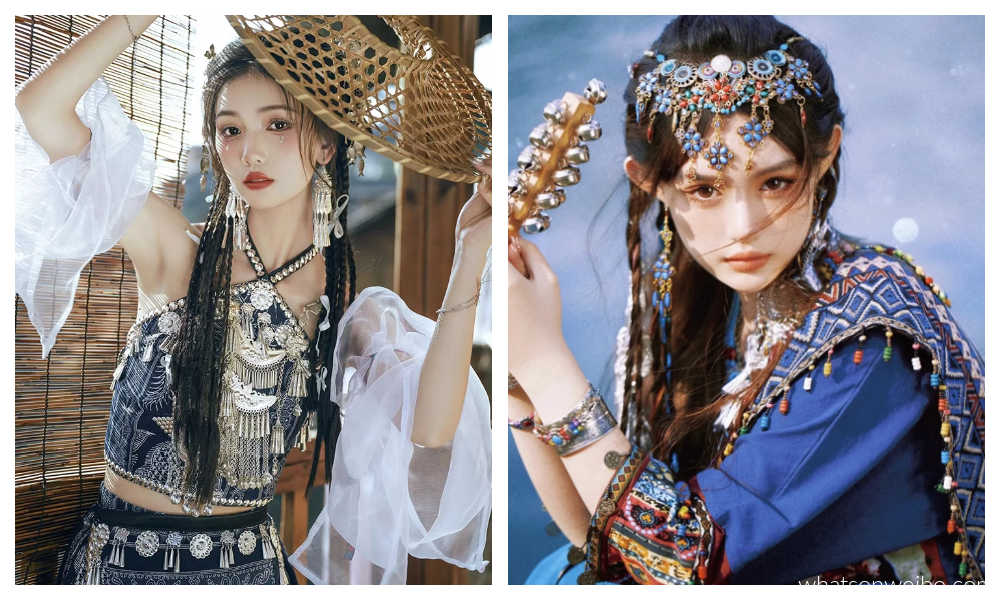
Images via photo studios promoting their services on Taobao.
While some may find the trend problematic and complex, many see it as merely photogenic and fun. In the end, regardless of where the ethnic photo hype ultimately will lead, it crystallizes a moment where the interplay of China’s social media’s lens, the surge in domestic tourism, and the intrigue surrounding ethnic minorities seamlessly intersect. Whether it’s a mere snapshot in time or a lasting chapter, this phenomenon captures a blend of cultural curiosity, social media dynamics, and new Chinese traditions in the digital era.
By Zilan Qian
Follow @whatsonweibo
Featured image is part of a ethnic photoshoot in Lhasa in 2021, copyright by What’s on Weibo.
This article has been edited for clarity and commissioned by Manya Koetse.
Get the story behind the hashtag. Subscribe to What’s on Weibo here to receive our newsletter and get access to our latest articles:
Spotted a mistake or want to add something? Please let us know in comments below or email us. First-time commenters, please be patient – we will have to manually approve your comment before it appears.
©2023 Whatsonweibo. All rights reserved. Do not reproduce our content without permission – you can contact us at info@whatsonweibo.com.
Zilan Qian is a China-born undergraduate student at Barnard College majoring in Anthropology. She is interested in exploring different cultural phenomena, loves people-watching, and likes loitering in supermarkets and museums.

China Brands, Marketing & Consumers
A Brew of Controversy: Lu Xun and LELECHA’s ‘Smoky’ Oolong Tea
Chinese tea brand LELECHA faced backlash for using the iconic literary figure Lu Xun to promote their “Smoky Oolong” milk tea, sparking controversy over the exploitation of his legacy.
Published
5 days agoon
May 3, 2024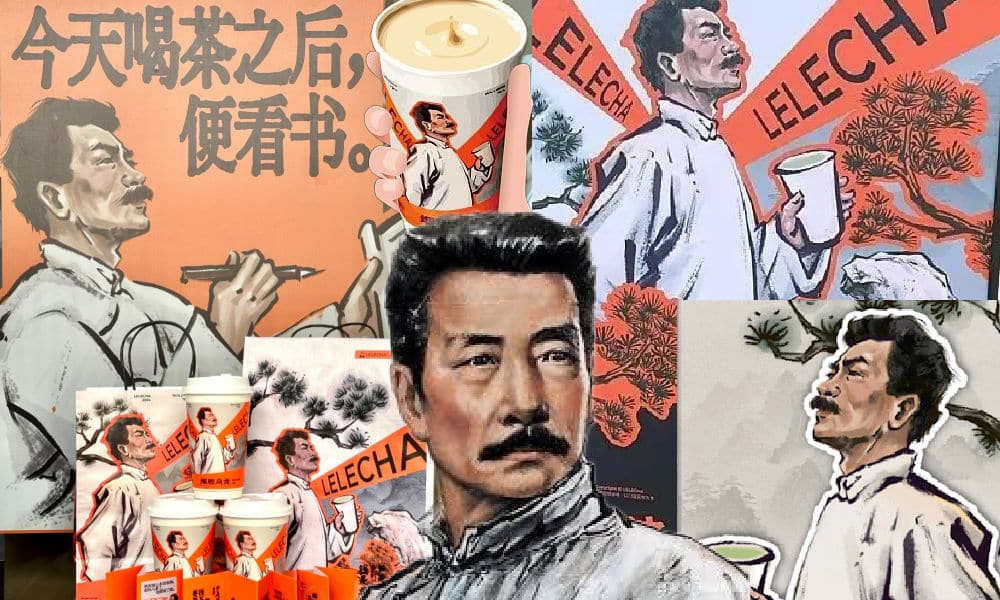
It seemed like such a good idea. For this year’s World Book Day, Chinese tea brand LELECHA (乐乐茶) put a spotlight on Lu Xun (鲁迅, 1881-1936), one of the most celebrated Chinese authors the 20th century and turned him into the the ‘brand ambassador’ of their special new “Smoky Oolong” (烟腔乌龙) milk tea.
LELECHA is a Chinese chain specializing in new-style tea beverages, including bubble tea and fruit tea. It debuted in Shanghai in 2016, and since then, it has expanded rapidly, opening dozens of new stores not only in Shanghai but also in other major cities across China.
Starting on April 23, not only did the LELECHA ‘Smoky Oolong” paper cups feature Lu Xun’s portrait, but also other promotional materials by LELECHA, such as menus and paper bags, accompanied by the slogan: “Old Smoky Oolong, New Youth” (“老烟腔,新青年”). The marketing campaign was a joint collaboration between LELECHA and publishing house Yilin Press.
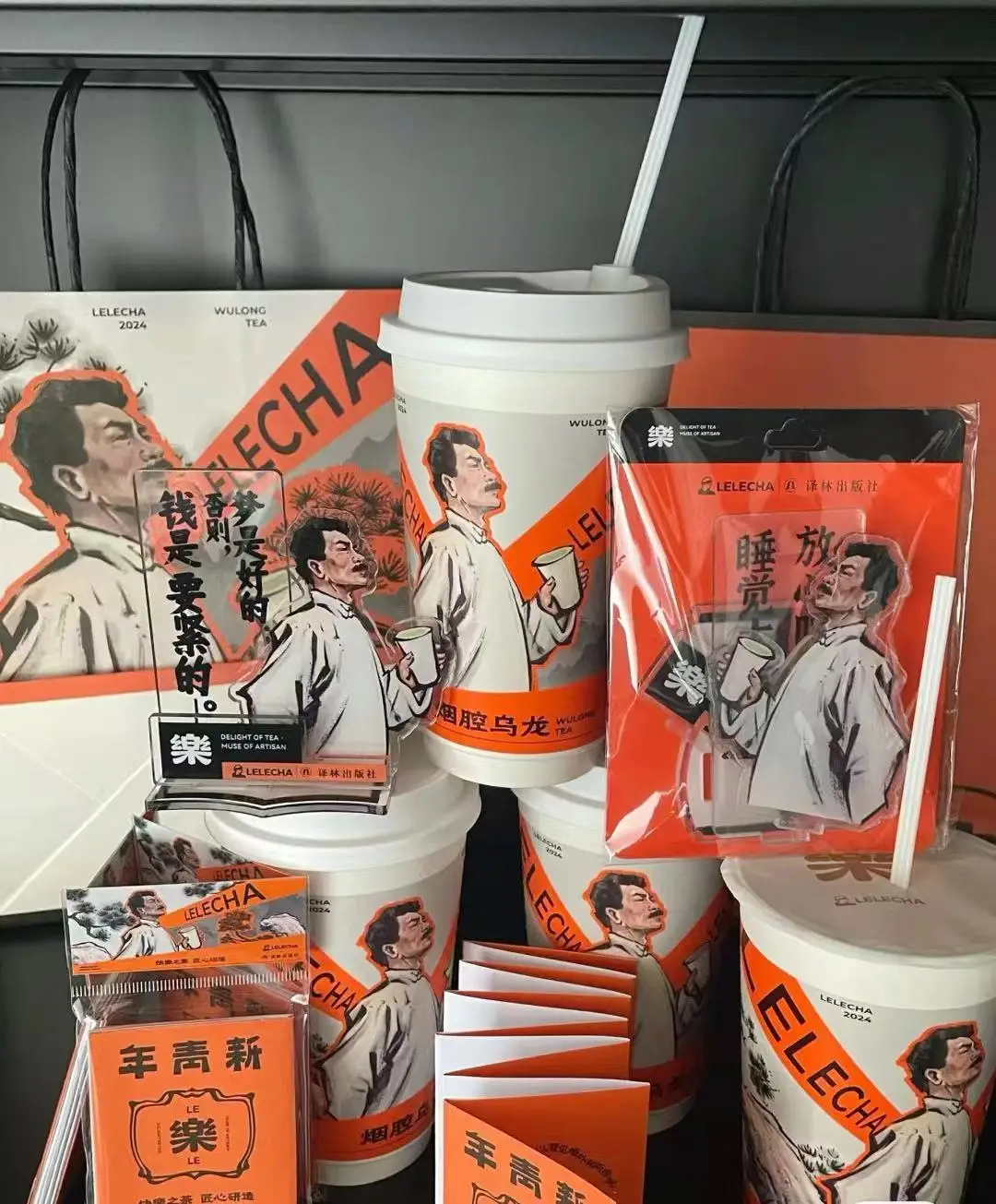
Lu Xun featured on LELECHA products, image via Netease.
The slogan “Old Smoky Oolong, New Youth” is a play on the Chinese magazine ‘New Youth’ or ‘La Jeunesse’ (新青年), the influential literary magazine in which Lu’s famous short story, “Diary of a Madman,” was published in 1918.
The design of the tea featuring Lu Xun’s image, its colors, and painting style also pay homage to the era in which Lu Xun rose to prominence.
Lu Xun (pen name of Zhou Shuren) was a leading figure within China’s May Fourth Movement. The May Fourth Movement (1915-24) is also referred to as the Chinese Enlightenment or the Chinese Renaissance. It was the cultural revolution brought about by the political demonstrations on the fourth of May 1919 when citizens and students in Beijing paraded the streets to protest decisions made at the post-World War I Versailles Conference and called for the destruction of traditional culture[1].
In this historical context, Lu Xun emerged as a significant cultural figure, renowned for his critical and enlightened perspectives on Chinese society.
To this day, Lu Xun remains a highly respected figure. In the post-Mao era, some critics felt that Lu Xun was actually revered a bit too much, and called for efforts to ‘demystify’ him. In 1979, for example, writer Mao Dun called for a halt to the movement to turn Lu Xun into “a god-like figure”[2].
Perhaps LELECHA’s marketing team figured they could not go wrong by creating a milk tea product around China’s beloved Lu Xun. But for various reasons, the marketing campaign backfired, landing LELECHA in hot water. The topic went trending on Chinese social media, where many criticized the tea company.
Commodification of ‘Marxist’ Lu Xun
The first issue with LELECHA’s Lu Xun campaign is a legal one. It seems the tea chain used Lu Xun’s portrait without permission. Zhou Lingfei, Lu Xun’s great-grandson and president of the Lu Xun Cultural Foundation, quickly demanded an end to the unauthorized use of Lu Xun’s image on tea cups and other merchandise. He even hired a law firm to take legal action against the campaign.
Others noted that the image of Lu Xun that was used by LELECHA resembled a famous painting of Lu Xun by Yang Zhiguang (杨之光), potentially also infringing on Yang’s copyright.
But there are more reasons why people online are upset about the Lu Xun x LELECHA marketing campaign. One is how the use of the word “smoky” is seen as disrespectful towards Lu Xun. Lu Xun was known for his heavy smoking, which ultimately contributed to his early death.
It’s also ironic that Lu Xun, widely seen as a Marxist, is being used as a ‘brand ambassador’ for a commercial tea brand. This exploits Lu Xun’s image for profit, turning his legacy into a commodity with the ‘smoky oolong’ tea and related merchandise.
“Such blatant commercialization of Lu Xun, is there no bottom limit anymore?”, one Weibo user wrote. Another person commented: “If Lu Xun were still alive and knew he had become a tool for capitalists to make money, he’d probably scold you in an article. ”
On April 29, LELECHA finally issued an apology to Lu Xun’s relatives and the Lu Xun Cultural Foundation for neglecting the legal aspects of their marketing campaign. They claimed it was meant to promote reading among China’s youth. All Lu Xun materials have now been removed from LELECHA’s stores.
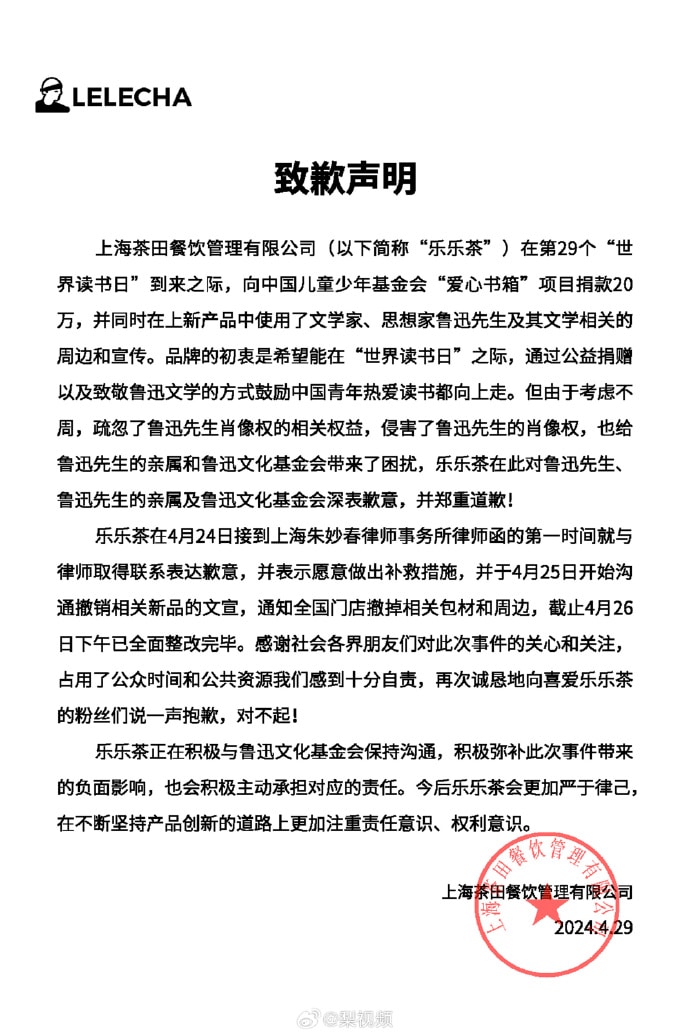
Statement by LELECHA.
On Chinese social media, where the hot tea became a hot potato, opinions on the issue are divided. While many netizens think it is unacceptable to infringe on Lu Xun’s portrait rights like that, there are others who appreciate the merchandise.
The LELECHA controversy is similar to another issue that went trending in late 2023, when the well-known Chinese tea chain HeyTea (喜茶) collaborated with the Jingdezhen Ceramics Museum to release a special ‘Buddha’s Happiness’ (佛喜) latte tea series adorned with Buddha images on the cups, along with other merchandise such as stickers and magnets. The series featured three customized “Buddha’s Happiness” cups modeled on the “Speechless Bodhisattva” (无语菩萨), which soon became popular among netizens.
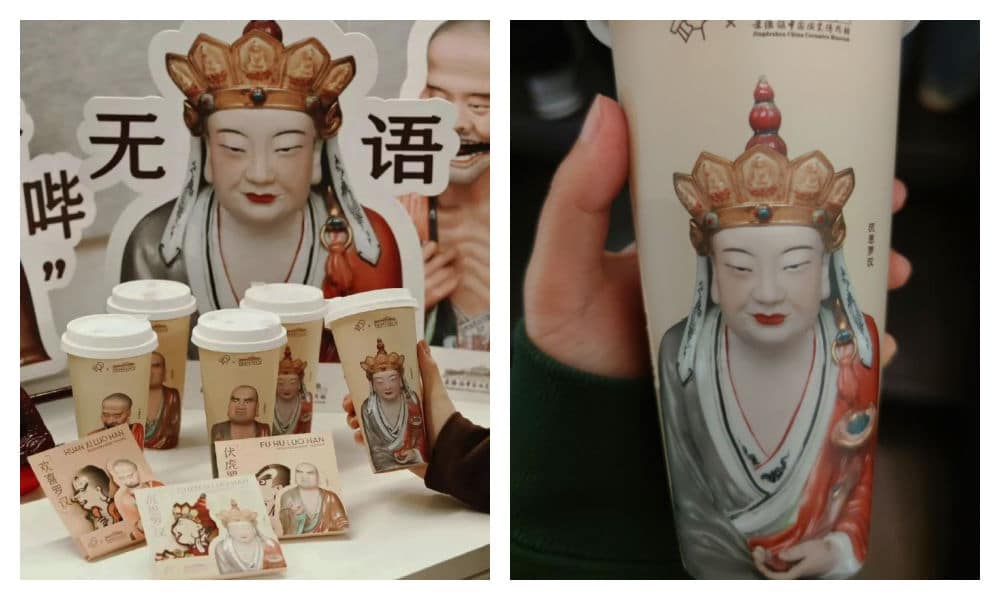
The HeyTea Buddha latte series, including merchandise, was pulled from shelves just three days after its launch.
However, the ‘Buddha’s Happiness’ success came to an abrupt halt when the Ethnic and Religious Affairs Bureau of Shenzhen intervened, citing regulations that prohibit commercial promotion of religion. HeyTea wasted no time challenging the objections made by the Bureau and promptly removed the tea series and all related merchandise from its stores, just three days after its initial launch.
Following the Happy Buddha and Lu Xun milk tea controversies, Chinese tea brands are bound to be more careful in the future when it comes to their collaborative marketing campaigns and whether or not they’re crossing any boundaries.
Some people couldn’t care less if they don’t launch another campaign at all. One Weibo user wrote: “Every day there’s a new collaboration here, another one there, but I’d just prefer a simple cup of tea.”
By Manya Koetse
[1]Schoppa, Keith. 2000. The Columbia Guide to Modern Chinese History. New York: Columbia UP, 159.
[2]Zhong, Xueping. 2010. “Who Is Afraid Of Lu Xun? The Politics Of ‘Debates About Lu Xun’ (鲁迅论争lu Xun Lun Zheng) And The Question Of His Legacy In Post-Revolution China.” In Culture and Social Transformations in Reform Era China, 257–284, 262.
Independently reporting China trends for over a decade. Like what we do? Support us and get the story behind the hashtag by subscribing:
Spotted a mistake or want to add something? Please let us know in comments below or email us. First-time commenters, please be patient – we will have to manually approve your comment before it appears.
©2024 Whatsonweibo. All rights reserved. Do not reproduce our content without permission – you can contact us at info@whatsonweibo.com.
China Brands, Marketing & Consumers
Zara Dress Goes Viral in China for Resemblance to Haidilao Apron
Who’s gonna buy this Zara dress in China? “I’m afraid that someone will say I stole the apron from Haidilao.”
Published
3 weeks agoon
April 19, 2024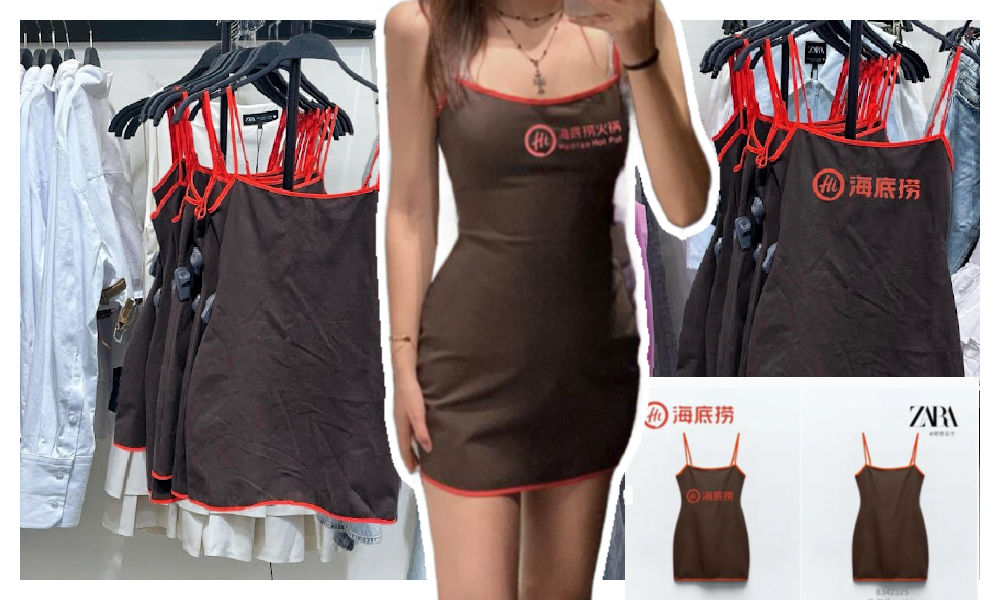
A short dress sold by Zara has gone viral in China for looking like the aprons used by the popular Chinese hotpot chain Haidilao.
“I really thought it was a Zara x Haidialo collab,” some customers commented. Others also agree that the first thing they thought about when seeing the Zara dress was the Haidilao apron.

The “original” vs the Zara dress.
The dress has become a popular topic on Xiaohongshu and other social media, where some images show the dress with the Haidilao logo photoshopped on it to emphasize the similarity.

One post on Xiaohongshu discussing the dress, with the caption “Curious about the inspiration behind Zara’s design,” garnered over 28,000 replies.
Haidilao, with its numerous restaurants across China, is renowned for its hospitality and exceptional customer service. Anyone who has ever dined at their restaurants is familiar with the Haidilao apron provided to diners for protecting their clothes from food or oil stains while enjoying hotpot.
These aprons are meant for use during the meal and should be returned to the staff afterward, rather than taken home.
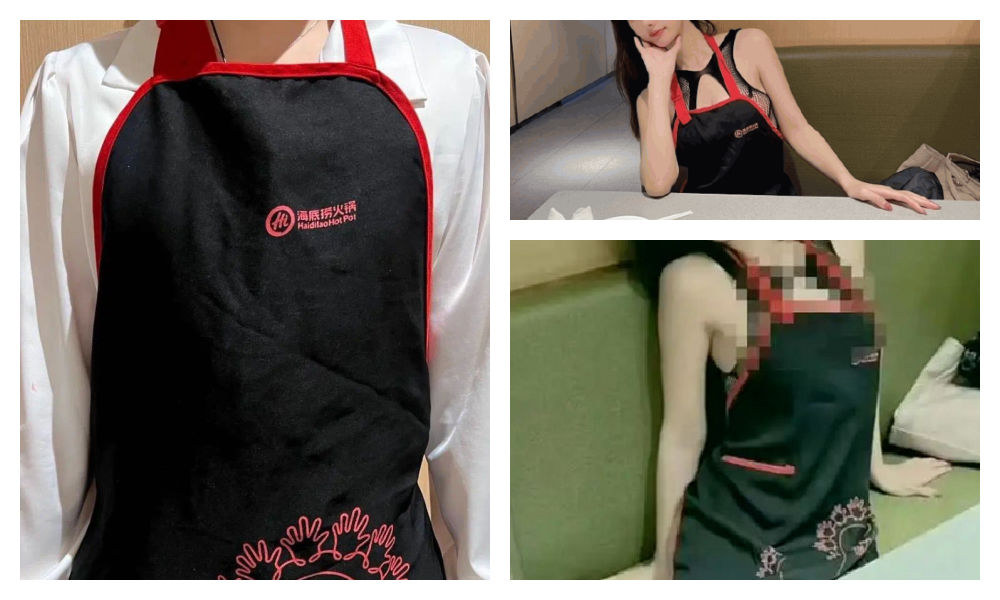
The Haidilao apron.
However, many people who have dined at Haidilao may have encountered the following scenario: after indulging in drinks and hotpot, they realize they are still wearing a Haidilao apron upon leaving the restaurant. Consequently, many hotpot enthusiasts may have an ‘accidental’ Haidilao apron tucked away at home somewhere.
This only adds to the humor of the latest Zara dress looking like the apron. The similarity between the Zara dress and the Haidilao apron is actually so striking, that some people are afraid to be accused of being a thief if they would wear it.
One Weibo commenter wrote: “The most confusing item of this season from Zara has come out. It’s like a Zara x Haidilao collaboration apron… This… I can’t wear it: I’m afraid that someone will say I stole the apron from Haidilao.”

Funnily enough, the Haidilao apron similarity seems to have set off a trend of girls trying on the Zara dress and posting photos of themselves wearing it.
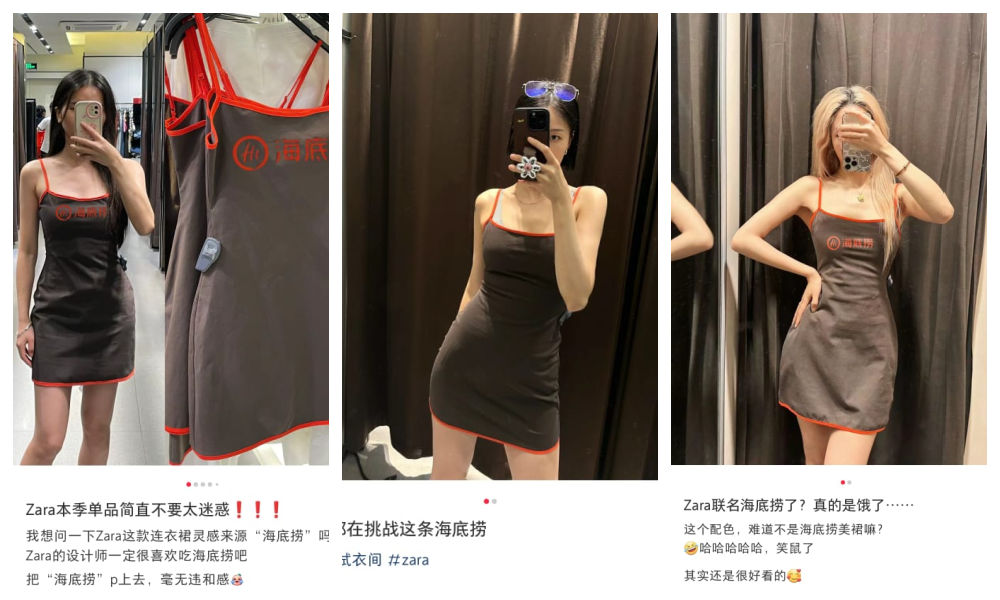
It’s doubtful that they’re actually purchasing the dress. Although some commenters say the dress is not bad, most people associate it too closely with the Haidilao brand: it just makes them hungry for hotpot.
By Manya Koetse
Independently reporting China trends for over a decade. Like what we do? Support us and get the story behind the hashtag by subscribing:
Spotted a mistake or want to add something? Please let us know in comments below or email us. First-time commenters, please be patient – we will have to manually approve your comment before it appears.
©2024 Whatsonweibo. All rights reserved. Do not reproduce our content without permission – you can contact us at info@whatsonweibo.com.
Subscribe

A Brew of Controversy: Lu Xun and LELECHA’s ‘Smoky’ Oolong Tea

Weibo Watch: The Battle for the Bottom Bed

Zara Dress Goes Viral in China for Resemblance to Haidilao Apron

“Old Bull Eating Young Grass”: 86-Year-Old Chinese Painter Fan Zeng Marries 36-Year-Old Xu Meng

Chengdu Disney: The Quirkiest Hotspot in China

The ‘Two Sessions’ Suggestions: Six Proposals Raising Online Discussions

Top 9 Chinese Movies to Watch This Spring Festival Holiday

“Old Bull Eating Young Grass”: 86-Year-Old Chinese Painter Fan Zeng Marries 36-Year-Old Xu Meng

Party Slogan, Weibo Hashtag: “The Next China Will Still Be China”

From Pitch to Politics: About the Messy Messi Affair in Hong Kong (Updated)

Chengdu Disney: The Quirkiest Hotspot in China

Looking Back on the 2024 CMG Spring Festival Gala: Highs, Lows, and Noteworthy Moments

More than Malatang: Tianshui’s Recipe for Success

Two Years After MU5735 Crash: New Report Finds “Nothing Abnormal” Surrounding Deadly Nose Dive

The Chinese Viral TikTok Song Explained (No, It’s Not About Samsung)
Get in touch
Would you like to become a contributor, or do you have any tips or suggestions? Get in touch here!
Popular Reads
-

 China Insight2 months ago
China Insight2 months agoThe ‘Two Sessions’ Suggestions: Six Proposals Raising Online Discussions
-

 China Arts & Entertainment3 months ago
China Arts & Entertainment3 months agoTop 9 Chinese Movies to Watch This Spring Festival Holiday
-

 China Arts & Entertainment3 weeks ago
China Arts & Entertainment3 weeks ago“Old Bull Eating Young Grass”: 86-Year-Old Chinese Painter Fan Zeng Marries 36-Year-Old Xu Meng
-

 China Media2 months ago
China Media2 months agoParty Slogan, Weibo Hashtag: “The Next China Will Still Be China”

